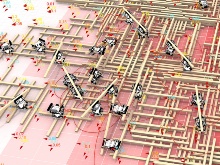Co-Design Methods for Collective Robotic Construction Systems in Architecture
Since the 1980s, advanced simulations from the field of distributed computing are converging with autonomous robotic systems into a new research field entitled multiple robot systems (MRS). This emerging field, which involves the execution of goals with multiple mobile machines, has received increasing attention due to its advantages of robustness, decentralization, parallelism and simplicity. As initial studies are now being developed into highly robust robotic systems enabled by the rapid technical developments on both hardware and software, questions of application are becoming more important for the future development of the field. Research is therefore transitioning beyond the initial exploration of simple tasks to complex real-world applications.
Collective robotic construction (CRC) is one of such newly defined fields that addresses questions of MRS for application in the Architecture, Engineering, and Construction (AEC) industry. This has included the exploration of teams of unmanned aerial vehicle for the assembly of foam brick towers, the development of custom machines for the creation of fibrous structures and self-replicating robots which collaborate to assemble structures out of custom voxel modules. As compared to existing practices in construction automation which deploy individual static industrial machines to assemble pre-planned building elements, CRC systems generally involve the development of custom machines that can fit within a suitcase, are mobile within their construction environments and can collaborate to assemble architectural structures which emerge through their creation. This new field introduces a series of new research question, specifically relating to the transformation of current practices and methods in the fields of AEC as CRC systems have the potential to disrupt the entire life cycle of a building from design to disassembly.
Although research in the field of CRC is currently expanding, current research tends to be highly discipline specific leading to contributions of generalized methods which ignore major constraints from other disciplines or highly custom in which the methods developed are only applicable to the CRC system at hand. This has therefore left fundamental research questions related to system integration for real architectural assembly and the general co-design of CRC system as unanswered. Therefore, the first major first major research question of this doctoral research is as follows:
1) How can the application of the principles of co-design lead to the deployment of CRC systems which integrate the interdisciplinary constraints embedded in such systems?
This doctoral research also addresses the architectural design of structures assembled by CRC systems from an architectural perspective. The process of designing an architectural structure to be assembled by a team of mobile robots is a process that must be completely re-envisioned from existing practice. Furthermore, the question of when the process of architectural design occurs affects the overall potential outcomes of the design process ranging from fully emergent to top-down design. This challenge will be investigated with two main research questions:
2) What computational methods can be utilized for the architectural design of structures with CRC systems?
3) How do different architectural design methodologies affect the overall workflow for design in the assembly of structures using CRC systems?
The core hypotheses of this dissertation can be broken down based on the two perspectives which it tackles CRC: (i) the co-design of the overall system, and (ii) the architectural design of the structures. Relating to the first, this dissertation hypothesizes that the exploration and generation of more architecturally relevant CRC systems can be achieved through the utilization of a co-design methodology in which interdisciplinary expertise can be engaged in the process. The second hypothesis is that agent-based modeling (ABM) is a promising method for exploring, not only, the structures which can be built by teams of mobile robots but also for investigating how different architectural design approaches can help to explore the range of top-down to bottom-up design methodologies with CRC systems.
These hypotheses together with the research aim will be investigated through a series of three case studies. The case studies are built upon an initial background research as well as stage of initial conceptualization. The three case studies are organized in order to validate the CRC ability to construct full scale architectural prototypes and showcase how different ABM definitions affect the architectural design process. The first case study will showcase how the developed CRC can complete tasks required for construction and a top-down approach to architectural design. The second case study will show how the CRC system can assemble planar building components and presents a method for architectural design in which the design and planning phases are merged. The optional final case study will conclude with a full architectural prototype in which the architectural design method allows for direct interaction with the physical system collapsing the design, planning and execution phases.
This dissertation addresses the issue of the automation of construction through the emerging field of CRC. Through the presentation of a co-design approach toward the development of CRC systems, this dissertation showcases how methodological advances from various disciplines can be combined in order to achieve high impact and highly robust systems. In doing such, this dissertation showcases how real architectural structures can be assembled and further rearranged by teams of small mobile robots in order to obtain the goal of more safe, inexpensive, and sustainable construction as promised by CRC.
PROJECT TEAM
ICD Institute for Computational Design and Construction, University of Stuttgart
Samuel Leder, Prof. A. Menges
PROJECT FUNDING
German Research Foundation (DFG), EXC 2120 IntCDC
BBSR Zukunft Bau
RELATED PUBLICATIONS
Contact Information

Samuel Leder
M.Sc.Research Group Leader | Distributed Robotic Construction


